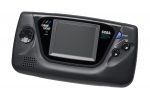Sega’s tumultuous history throughout the 90’s was made up of a lot of hardware firsts. Well, firsts that ended up working better on paper than they did in practice. One such instance was the hybrid console. While the Nintendo Switch is ruling the roost today, it certainly didn’t invent the concept. Though they arguably did it in a far more elegant way than what Sega had pulled off some twenty years earlier.
Now, at its most basic, a hybrid console is any handheld that can be connected to a TV. When we talk about handhelds being console replacements, this is pretty much the concept taken to its logical conclusion. A single device that fulfills both niches. Of course there are going to be some caveats. The compact form factor and battery requirements of a portable are going to mean trade offs in performance. However, the technology has now evolved to the point where you can get a full fat console gaming experience from these devices. And actually, you could in 1995 as well.
At the time, Nintendo wasn’t doing so hot. Sure, the Game Boy was still selling fairly well despite being six years old by this point. However, it was getting clear that the House of Mario needed to reinvigorate their portable line should they want to ensure market dominance. Pokemon was still a year away, and certainly not a guaranteed hit. So they did what they do best; jump head first into gimmicks. People were going nuts about virtual reality, so Nintendo decided to put out their own 32-bit “VR” headset that could play games in stereoscopic 3D. The Virtual Boy still stands as the company’s single biggest stinker, and their worst selling video game product. This was just the gap in the armour that Sega needed to seize handheld supremacy from their rival.
Our story begins a few years prior, in the early 90’s when parachute pants ran wild and Jaleel White’s career was still relevant. Sega had recently partnered with Japan Airlines to offer video games to their passengers. They figured the best approach would be to once again take existing hardware, and shrink it down to a handheld form factor. The end result was the Mega Jet, a Mega Drive crammed into a case roughly the size of a Game Gear. The device featured a six button controller and could accept full sized cartridges. However, it was not a true handheld. It still required an external display and power to operate, which were located in the armrests. In the days before long haul airliners had a TV in the back of every seat, this surely would have delighted bored passengers who had splurged on first class tickets.
The Mega Jet saw a limited retail release in Japan, but was ultimately a very niche product. Only useful in cars that had TVs built in. Which, let me remind you, is long before larger LCD panels became practical, let alone cost effective. So basically your rich guys with a limo and a passion for gaming. The concept proved sound though, so Sega began working on moving the Mega Jet up to the next level.
Under the code name “Project Venus”, they took the basic innards of the Mega Jet and put them in a new handheld shell. One which included a full colour, backlit 3.25” display running at 320×244, the native resolution for NTSC Genesis titles. And much like its airborne counterpart, it could also accept full sized Genesis cartridges. Essentially giving the device instant access to the a library of over 500 games.
Perhaps its biggest trick though was the inclusion of an A/V port. Players could use the cables from the Model 2 Genesis to connect their handheld to any TV. It also had a controller port to allow a second player, and even supported the myriad of peripherals of its bigger console brother. Well, most. You couldn’t use the Power Base Converter for Master System titles, nor the 32X. So you were SOL if you wanted to access those libraries in the days before Everdrive and FPGA carts.
Now, if you’re thinking this would be a mess of cable spaghetti, well, you’d be right. Docking stations, such as what the modern Switch has, weren’t unheard of in 1995. Though such a setup likely would have added to the cost of the device, now dubbed the “NOMAD”, which was already pretty expensive as is. Besides, if you were playing solo, on batteries, you’d only have the one cable tethered to the TV. Not much different than a regular Genesis in the days before wireless controllers became ubiquitous.
The NOMAD launched in North America only in October of 1995, at a cost of $180 ($310 in 2021). Which, if you’ll recall, is the same price the Genesis launched for back in 1989. Not exactly a bargain by any means. And, unlike its bigger brother, didn’t even have the courtesy to include a pack-in game. Making it a bit more expensive actually than the bog standard Genesis ever was.
Sega had also done little to correct the flaws of their original handheld. Indeed, things had somehow gotten worse. This was an utterly massive device that still needed six AA batteries to power it. Furthermore, it featured the same power requirements as the bigger console; 9-volts and 850mAh. Giving it 2 hours of battery life from standard alkaline cells. Sega did not recommend the use of NiCd rechargeable batteries due to their lower voltage. Not that it mattered, since they would only deliver less than one hour of playtime.
Yet, despite these limitations, the NOMAD actually received quite a positive reaction from the gaming press. EGM called it the best handheld available on the market at the time. Though did criticize its battery life issues.
However, the initial praise did little to sway the public. While the NOMAD was the first 16-bit handheld to reach the market, and had a robust library of games attached to it, it never really took off. Most of the gaming world had moved on to 32-bit systems. As had Sega, who had ended Genesis development and was focusing entirely on the Saturn. Then when Pokemon released for the Game Boy the following year, all attention had drifted back to Nintendo.
While the idea of having a portable Genesis seemed like a cool concept, the NOMAD lacked any killer exclusive apps to entice players to buy it. It was entirely reliant on a library of older games everyone had already played, from a system all potential customers likely already owned. Sega quickly dropped the price by $100. Then again to a third of its original MSRP. Though this did little to encourage consumers to pick up the system. Sega discontinued it in 1999 after a surprisingly respectable four years on the market. A total of 1 million units were sold, one tenth that of the Game Gear.
Today, the NOMAD has become a bit of a cult classic among Sega fans. Due to the low sales, systems have maintained their price on auction sites and retro game shops. It’s legacy as the first hybrid console has continued to this day. First with the PSP-2000 and PSP Go, then followed up with the Switch juggernaut. Proving that there was something too the concept, and that Sega were ahead of their time.





